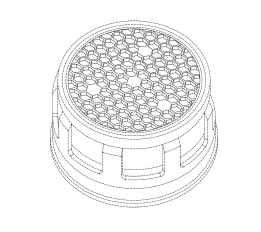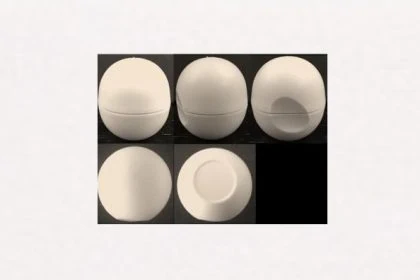The position mark “hole pattern” in the sanitary area is devoid of distinctive character, today the European Court held. The position mark should have deviated significantly from the industry norm, as the mark merges with the product.
According to general case-law, signs which merge with the appearance of the goods are distinctive only if they deviate significantly from the industry norm and customary practice in the industry. In this sense, the European Court already ruled this year in the case of the Position mark Bottle cap: no distinctive character.
The facts

This was also the focus of today’s case before the European Court (CFI) about a position mark as a hole pattern. On 17 January 2017, the plaintiff, Neoperl AG, applied for a position mark as a union mark. The representation of the position mark shows four filled holes in a regular hole pattern. The position mark was applied for in respect of goods in the sanitary sector falling within Class 11 Nice (‘Sanitary drains’).
However, the requested trade mark registration was refused by both the DPMA and the Board of Appeal on the grounds of lack of distinctive character. The impression of the mark applied for differed only slightly from that of conventional jet regulators, since the filled holes would at best be perceived as a decorative or functional element and not – as Neoperl claims – as a representation of an astonished face similar to an emoji, the Board of Appeal gave reasons for its decision (‘the contested decision’), which was heard today before the European Court.
Positional mark not sufficiently taken into account?
Neoperl pleaded infringement of Article 7(1)(b) of Regulation 2017/1001. In particular, Neoperl argued that insufficient account had been taken of the specific nature of the positional marks, which existed in its specific position as applied for.
In addition, Neoperl accused the Board of Appeal of underestimating the public’s attention. On the contrary, the relevant public (sanitary installers, plumbers or informed do-it-yourselfers) would pay greater attention to the mark, especially since the outlet part within a fitting is of greater importance, the applicant claimed. The relevant public would see in the filled holes an unusual and memorable design.
Case law on the position mark and the 3D mark
It is also settled case-law that the criteria for assessing the distinctive character of 3D marks consisting of the appearance of the product itself are no different from those applied to other categories of mark. However, the CFI added that it must be borne in mind that a three-dimensional mark consisting of the appearance of the product itself is not necessarily perceived by the average consumer in the same way as a word or figurative mark which is independent of the product. In the absence of graphic or word elements, the average consumer does not normally infer from the shape of the goods or their packaging their origin, the Court explained.
You are also welcome to read it in this context: Surface patterns difficult to protect as trade marks (Birkenstock Sales v EUIPO, September 2018).
Therefore, according to case-law, a mark which is particularly close to the shape of the mark – such as a positional mark – is only distinctive if that mark departs significantly from the industry norm or custom and can therefore fulfil its essential function of identifying origin. That is the case even though position marks are close to the categories of figurative marks and three-dimensional marks.
The decisive factor for the application of this case law is whether the trade mark merges with the appearance of the designated product, the CFI explained.
Position mark merges with the product
This is the case here, the European Court ruled. Given the essential characteristics of positional marks which are characterised by their particular placement or affixing on a product and the nature of the goods in question, the mark applied for would not exist without being associated with the goods in question, so that it necessarily merges with the appearance of those goods, in this case sanitary runners.
The Board of Appeal therefore took sufficient account of the nature of the mark applied for as a positional mark and rightly applied the criterion that distinctiveness can exist only where there is a significant departure from the sectoral norm.
There is no such deviation from the sectoral norm in the case of the mark at issue. The impression of the sign differs only slightly from that of conventional jet regulators, the CFI ruled. The relevant consumer will perceive the sign only as a design variant customary for the type of goods in question.
Originality is not a criterion of distinctiveness
The Court pointed out that novelty or originality are not relevant criteria for assessing the distinctive character of a mark and rejected the applicant’s argument that the mark was special because of its abstract and unique arrangement.
Attention by the specialist public
The Court also rejected the applicant’s argument that the Board of Appeal considered the public’s level of attention to be too low. Even though, as in the present case, greater attention can often be attributed to a specialist public, the Court of First Instance held that it is by no means inevitable that the sign’s less distinctive character is sufficient where the relevant public is technically specialised. Furthermore, the Court pointed out that the assessment of distinctiveness did not depend on whether similar signs were actually used on the market.
Lack of distinctive character of the position mark
Since the applicant Neoperl had not shown that the possible deviations from the industry norm – or even from the most common designs – were sufficiently characteristic or distinctive, the CFI confirmed the decision of the Board of Appeal. The applicant submits that the position mark applied for is devoid of any distinctive character and that the refusal to register the mark was therefore justified.
Would you also like to protect your trademark or brand name?
Or do you need advice on whether it makes more sense to register a figurative mark, a 3D mark or a position mark?
If you are interested, please contact us – you are also welcome to use our recall offer!
Sources:
Judgement of CFI EU:T:2019:788
Image:








Leave a Reply